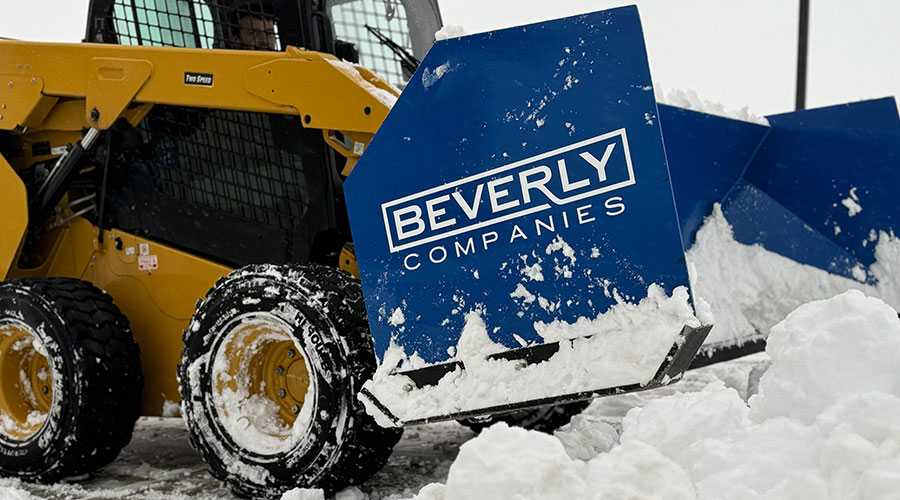Maximizing Melters
Ice-melting products can keep sidewalks clear but only if managers understand their true costs and benefits
Ice melters are essential elements in efforts to keep sidewalks and parking lots and structures free of ice and snow. Grounds care managers have access to a growing array of ice-melting products today. And advertising claims such as “fastest acting,” “safe for environment,” “less tracking,” and “melts at lowest temperatures” are among the more common sales pitches.
But managers shouldn’t be fooled by creative marketing. Most so-called new products are actually blends of common deicers that have been around for years. Unfortunately, some ice-melting products on the market do not even list their ingredients, so buyer, beware. Managers can use the following insights to cut through the hype and make the best choice.
Most chemical ice melters on the market are made from these basic ingredients:
-
sodium chloride, or rock salt
-
potassium chloride and urea
-
magnesium chloride
-
calcium chloride
-
sodium acetate
-
calcium magnesium acetate (CMA)
-
potassium acetate.
By knowing the characteristics of each raw material, managers can decide which products will be most effective for a given situation. They can check the percentage of each material to determine the true quality of the product.
Chemical Considerations
Sodium chloride. Rock salt is the most commonly used ice melter. Its irregularly shaped crystals are inexpensive compared to other materials. But it has limited effectiveness in very cold temperatures. Rock salt will not melt ice below 20 degrees.
Rock salt does not chemically attack concrete, but it is corrosive to rebar and steel. Sodium also can be toxic to vegetation and can build up in the soil, causing permanent damage. Rock salt also leaves a white powdery residue.
Potassium chloride and urea. Many people believe that these common fertilizers are safe products to use around vegetation, but this is a common misconception. Fertilizer is good for plants, but at high concentrations, it can be deadly. Urea does not contain chlorides, so it is less corrosive and safer for use on concrete containing rebar and around steel structures. Urea is effective to 15 degrees and potassium chloride to 12 degrees. Both materials work more slowly than calcium chloride.
Magnesium chloride. This product offers many benefits and is very similar to calcium chloride: It is considered less corrosive, safer on concrete, less damaging to vegetation, animals and humans, and tracks less than calcium chloride. The main drawback to magnesium chloride is that it is only 48 percent active and needs to be applied at a higher rate than calcium chloride. Magnesium chloride will melt down to 5 degrees.
Calcium chloride. This liquid brine is converted into pellets and flakes by removing the water. It quickly absorbs moisture from the atmosphere, while rock salt, potassium chloride and urea must come in direct contact with moisture, which is not available at low temperatures.
When calcium chloride is converted into a liquid, it gives off heat. Rock salt, potassium chloride and urea need heat to work. Calcium chloride will melt ice at temperatures down to -25 degrees. The cost of calcium chloride might be a prohibiting factor, as it can run 40-50 cents per gallon. Also, applying it too heavily can produce oily residue.
A new corrosion-inhibited grade of liquid calcium chloride is designed to meet or exceed deicer standards. Other advantages of the new formulation are its ability to cut through snow and ice more quickly than rock salt or magnesium chloride, its lack of sediment problems in tanks, and easier cleanup of vehicles.
A Closer Look at Acetates
Sodium acetate. This dry formulation is used on bridges, parking decks and airport runways. It does not attack rebar in reinforced concrete and is biodegradable, creating no problems in runoff water. It changes ice and snow into an oatmeal-like texture, making it less desirable for use on walkways.
It also can be cost-prohibitive. Acetate products can cost around $2.50 per gallon — four to five times more than calcium chloride. Sodium acetate and CMA are effective down to 0-5 degrees, and they melt rapidly, similar to calcium chloride.
CMA. This dry formulation often is used as a corrosion inhibitor and is blended with road salt. Managers should look for blends of 20 percent or more CMA. It generally is used in a solid form and spread on the surface. CMA is also available in liquid form and is generally used for preventing ice formation on roads, bridges, and parking structures. CMA is biodegradable, has a residual effect and requires fewer applications.
Two innovative products being developed and tested in Kansas and Illinois are a whey-based CMA product and liquid corn salt. These products could be exceptional because of their effectiveness in ice and snow management, as well as being safer for the environment. Because they are made from raw materials such as corn and whey both are readily available and renewable.
Potassium acetate. This clear liquid contains no chlorides. It is safer for use on structural steel and reinforcing steel embedded in concrete. It readily biodegrades and has little environmental impact. Potassium acetate is effective down to -15 degrees F. It requires no agitation and has a residual effect, so fewer applications are necessary.
Ammonia-based ice-melting products, such as ammonium nitrate and ammonium sulfate, are used as fertilizers. They are not recommended for use as ice melters because they have been found to chemically attack and damage concrete.
Making the Choice
In purchasing ice melters, managers must consider the characteristics that are most important for a facility. The main reason for using ice-melting products is safety — reducing or inhibiting ice accumulations as quickly as possible to maintain a safe environment for pedestrians and vehicles.
Beyond that, different managers might have different priorities. For example, bridges or areas near exposed steel might require non-corrosive materials, areas around environmentally sensitive sites deserve non-chloride and biodegradable products, and products that are fast acting and easy to cleanup might be priorities near building entrances.
When considering melting issues, weather conditions also play a central role in choosing products. In extremely cold weather, rock salt will be the least effective choice. While managers cannot predict the weather, they can base decisions for preseason purchases on historical data.
Timing, Speed and Cost
Decisions regarding the timing of applications is not as easy. Monitoring weather forecasts and luck plan important roles in timing activities correctly.
Many organizations now find that pre-wetting pavement with liquid deicers increases the speed and effectiveness of solid products. Pre-wetting provides the moisture necessary to begin the melting process for some products. The process also reduces both the bounce and blowing of pellets or crystals.
Applying products before winter precipitation also is becoming a common practice. Pre-treating might eliminate the need for ice- or snow-removal operations, and it can inhibit ice and snow from sticking to the pavement, which saves time in snow-removal operations.
Chemical makeup is a primary consideration in determining the speed at which a product works. In general, liquids are fastest, followed by spherical pellets that cut vertically through snow and ice, allowing the brine to reach the pavement faster.
Managers will need to consider cost but not simply the cost of the product per pound or gallon. Consider its application rate and residual effect, as well as storage and inventory costs. Some products might seem more expensive at first, but application rates and storage and inventory costs might be lower. All of these factors can translate into reduced labor.
The Final Choice
When deciding on a specific to use, managers must check availability of products locally and the packaging options. Is purchasing in bulk, bag or gallon jugs most cost-effective? Is the product readily available and nearby, or will the department have to maintain a large inventory to meet possible demand? Choosing products manufactured in the region is likely to be most cost-effective. Shipping should also be considered and will affect the cost of the product.
Finally, managers must take time to educate themselves on the gamut of products available. A degree in chemistry is not required. Instead, managers should speak with knowledgeable and reputable sales representatives and other grounds care managers in the area to discuss specific site needs and to determine the most effective, safe and economical products. Purchasing any ice-melting product without full knowledge of its compounds and their percentages is asking for trouble.
First, Do No Harm
In selecting ice-melting products, grounds care managers must consider the cost of potential damage to expensive equipment, infrastructure and the environment. The price of the ice melter might seem high, but what is the price if workers don’t use the right product?
The goal is to choose products that are appropriate for the situation — for example, using non-corrosive — non-chloride — products on bridges and other structures with exposed steel. Also, choose products that will not damage carpets or tile at the main entrances of buildings. As far as tracking and cleanup, removing slush and snow as quickly as possible and using doormats will assist in clean up.
All products could have damaging effects if used at improper rates. Improper application rate is probably the number one cause of damage, not the use of the product itself.
According to the Concrete Institute, damage to concrete is primarily the result of freeze/thaw cycle on poor quality concrete. Chemicals such as sodium chloride and calcium chloride have very little effect on concrete. Ice melters, however, do increase the number of freeze/thaw cycles in a given season. To reduce freeze and thaw, choose products that have a low freezing point.
|
Related Topics:










